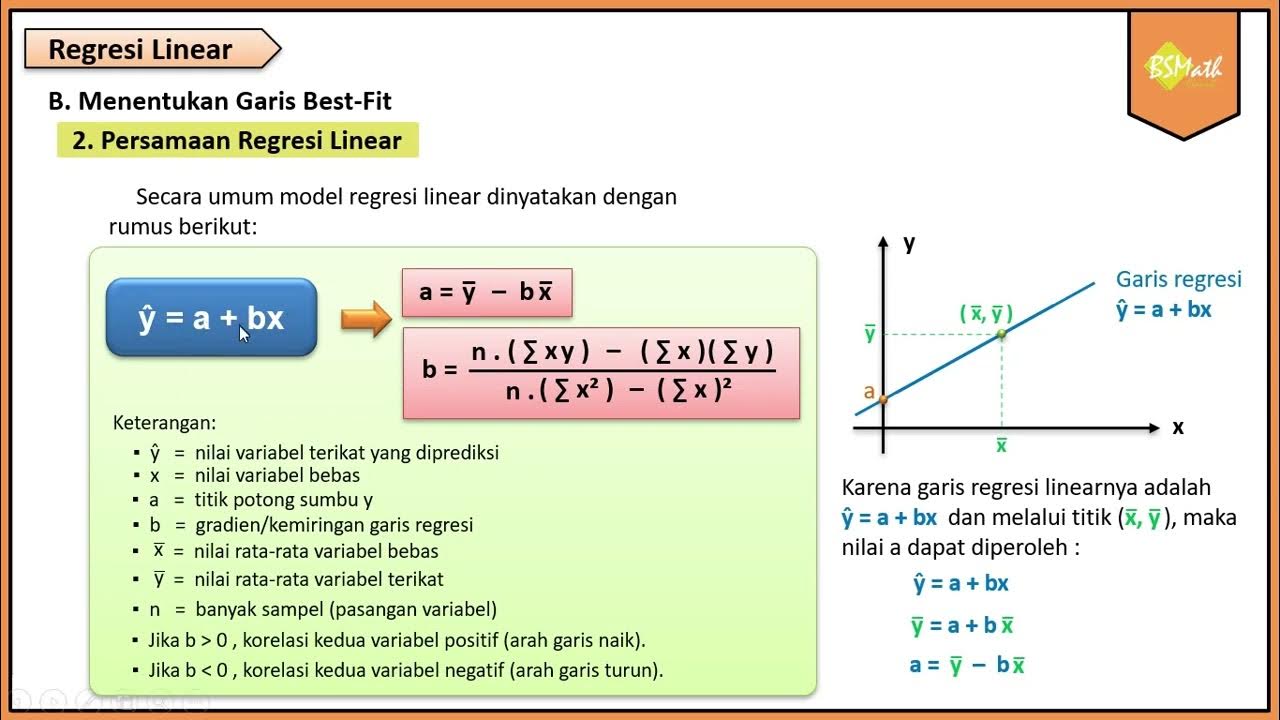[python] Program Regresi Linear Sederhana
Summary
TLDRIn this video, the presenter explains how to calculate a simple regression equation using Python. The tutorial covers the process of importing necessary libraries, handling data from a CSV file, and visualizing it using graphs. The presenter also demonstrates calculating constants and correlation coefficients manually, then shows how Python's built-in libraries simplify these tasks. The video includes a practical example of predicting weight based on calorie intake, and concludes with an explanation of how to use tables for coefficient calculation, providing a comprehensive guide for beginners interested in regression analysis with Python.
Takeaways
- 😀 Import necessary libraries such as pandas, matplotlib, and sklearn for linear regression and data visualization.
- 😀 Load the dataset from a CSV file containing caloric intake and body weight data.
- 😀 Prepare the data by separating the independent variable (calories) and the dependent variable (body weight).
- 😀 Plot a scatter graph to visualize the relationship between caloric intake and body weight.
- 😀 Manually calculate the regression coefficients (a and b) and the correlation coefficient (r) using formulas.
- 😀 Compute the R-squared (R²) value to assess the goodness of fit for the regression model.
- 😀 Use Python's sklearn library to perform linear regression automatically and compare the results with manual calculations.
- 😀 Predict body weight based on caloric intake using the regression model.
- 😀 Demonstrate how to input custom data (caloric intake) and predict corresponding body weight using the trained model.
- 😀 Discuss the option of using a table for manual calculations, although it is not necessary with Python's built-in functions.
Q & A
What is the purpose of the tutorial in the video?
-The tutorial demonstrates how to solve a simple regression equation using Python and apply it to predict weight based on daily calorie intake.
What libraries are imported in the Python code for this regression analysis?
-The libraries imported are pandas (for data manipulation), matplotlib (for plotting graphs), and sklearn (for regression modeling).
How is the data loaded into the Python program?
-The data is loaded from a CSV file using pandas' `read_csv` function, which reads the file and stores it in a DataFrame.
What are the variables assigned in the code for regression analysis?
-The variables `x` and `y` are assigned to the 'calories' and 'weight' columns of the DataFrame, respectively.
How does the tutorial visualize the data?
-The data is visualized by plotting a scatter plot using the matplotlib library, with 'calories' on the x-axis and 'weight' on the y-axis.
What constants are calculated in the regression analysis?
-The constants calculated are the slope (b), intercept (a), and the R-squared value, which indicates the strength of the linear relationship between calories and weight.
How are the regression constants calculated manually in the script?
-The constants are calculated manually using formulas for the slope (b) and intercept (a) based on the data, and the R-squared value is computed for correlation analysis.
What is the advantage of using the sklearn library for regression?
-Using sklearn simplifies the regression process, as it automatically calculates the slope, intercept, and R-squared values, saving time and reducing the complexity of manual calculations.
How does the Python code predict weight based on daily calorie intake?
-The code predicts weight by taking an input for daily calorie intake, then applying the regression formula: `y = a + b * x`, where 'a' is the intercept, 'b' is the slope, and 'x' is the input calorie value.
What is the role of the data table mentioned in the video?
-The data table is used to assist in manually calculating the regression constants, although the tutorial shows that this can be bypassed by using the `sklearn` model for efficiency.
Outlines

Cette section est réservée aux utilisateurs payants. Améliorez votre compte pour accéder à cette section.
Améliorer maintenantMindmap

Cette section est réservée aux utilisateurs payants. Améliorez votre compte pour accéder à cette section.
Améliorer maintenantKeywords

Cette section est réservée aux utilisateurs payants. Améliorez votre compte pour accéder à cette section.
Améliorer maintenantHighlights

Cette section est réservée aux utilisateurs payants. Améliorez votre compte pour accéder à cette section.
Améliorer maintenantTranscripts

Cette section est réservée aux utilisateurs payants. Améliorez votre compte pour accéder à cette section.
Améliorer maintenantVoir Plus de Vidéos Connexes

Cara Menghitung Analisis Regresi Sederhana secara Manual

Uji Regresi Linier Sederhana Dengan SPSS | Pembahasan Lengkap!

Metode Statistika | Analisis Regresi Linier | Part 1 Menentukan Persamaan Regresi

Data Mining 10 - Estimation (Linear Regression)

Regresi Resisten (Garis Resisten)

Persamaan Regresi Linear - Matematika Wajib SMA Kelas XI Kurikulum Merdeka
5.0 / 5 (0 votes)
